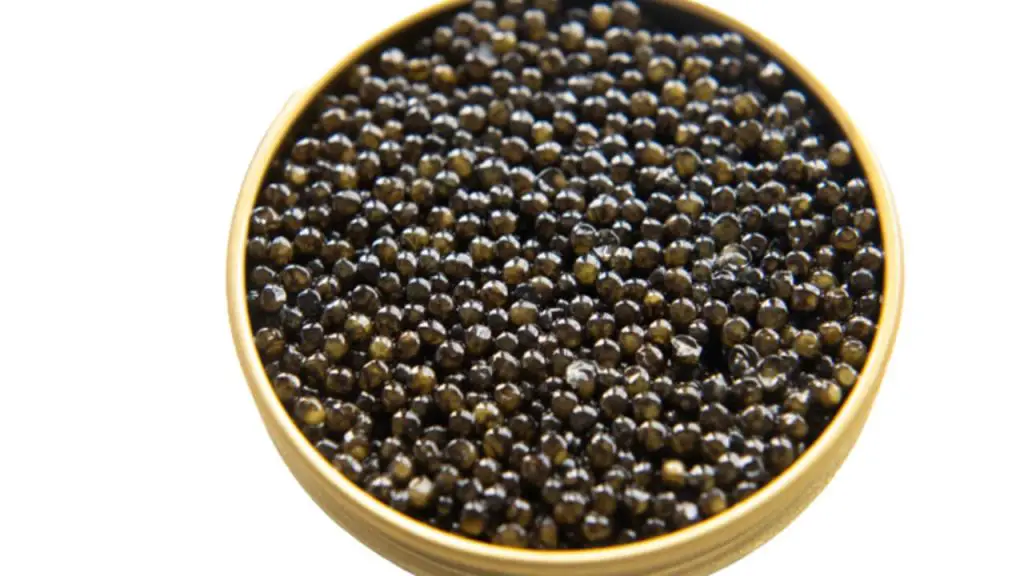If you have never tasted caviar before, you may be wondering what it tastes like. Caviar is a type of fish egg that is often eaten as a delicacy. Some people say that caviar has a salty taste, while others describe it as being slightly fishy.
Whether or not you enjoy the taste of caviar may come down to personal preference. Either way, it is definitely a unique experience!
What does caviar taste like?

Caviar is a food that is often associated with luxury and wealth. Caviar is considered a delicacy, and as such, it has a unique taste that some people find quite pleasant while others may find it an acquired taste.
It’s made from the eggs of sturgeon fish, and it can vary widely in flavor depending on the species of fish, the environment in which it was raised, and the methods used to process the eggs.
The main flavor notes in caviar are salt and fish, with a slightly nutty undertone. The texture can vary depending on the type of caviar, but it is generally soft and slightly oily.
When caviar is of high quality, it should melt in your mouth and have a distinct but not overwhelming flavor.
If the caviar is poorly sourced or of poor quality, it can be bitter or have an unpleasant aftertaste. Caviar is usually eaten as an hors d’oeuvre or starter, and it is often served on toast or crackers.
Caviar can be a controversial food because of the way it is produced. Sturgeons are wild animals, and their eggs are harvested in a process that can be harmful to the fish. As a result, caviar is sometimes considered to be an unethical food choice.
Overall, caviar is an acquired taste that is worth trying if you enjoy seafood or other salty foods.
Does caviar pop in your mouth?
Caviar is one of the most luxurious and exclusive foods in the world, prized for its delicate flavor and luxurious texture.
The eggs are harvested from sturgeon that have been carefully raised on special farms, and the process of barrel-aging the caviar helps to develop its unique flavor profile.
The eggs are typically firm and slightly crunchy, but they can also be soft and creamy. Caviar is often served as an appetizer with crackers or bread, but it can also be used in more creative dishes.
One of the most distinctive features of caviar is its pop – a sensation that comes from the slightly salty taste and firm texture of the eggs. When caviar is served fresh, it can provide a truly unique culinary experience.
For those who have never tasted caviar before, the pop can be a revelation – an explosion of flavor that is both salty and slightly sweet.
Whether you’re a caviar aficionado or you’re just curious about this luxurious food, we hope you’ll give it a try!
What is caviar famous for?
Caviar is one of the world’s most famous and luxurious foods. It is made from the eggs of sturgeon fish and has been prized for centuries for its unique flavor and texture.
The most prized caviar comes from the beluga sturgeon, which is found in the Caspian Sea. Beluga caviar is soft and delicate, with a slightly sweet flavor. It is also the most expensive type of caviar, costing up to $100 per ounce.
These days, caviar is still considered a delicacy and is often served on special occasions or as a high-end appetizer. While it can be expensive, many people believe that caviar is worth the price tag.
The eggs are typically salted and then canned or jarred, which helps to preserve their flavor and freshness.
Caviar can be eaten on its own or with other dishes and is often served with Champagne or white wine. Whether you are enjoying it as a special treat or serving it to guests, caviar is sure to make any occasion memorable.
How to eat caviar?
Many people are intimidated by caviar, thinking it is only for special occasions or that it is too expensive to enjoy on a regular basis. However, caviar is actually quite easy to eat and can be a delicious addition to any meal.
First, make sure the caviar is at room temperature before serving. It should be spooned onto crackers or toast points and can be eaten plain or with a variety of toppings. Experimentation is key when it comes to finding the perfect topping for your caviar.
Common choices include sour cream, onion, hard-boiled egg, and chives. But don’t be afraid to get creative-fruit, cheese, or even chocolate can all make delicious accompaniments to caviar.
The most important thing is to enjoy your caviar however you like it!
Nutritional value of caviar
Caviar is a luxury food made from the eggs of sturgeon fish. It has a long history, dating back to ancient times when it was enjoyed by royalty and nobility.
Today, caviar is still considered a special treat, and its unique taste and texture make it a popular choice for gourmet dishes.
However, caviar is more than just delicious food; it also boasts a number of nutritional benefits. Caviar is an excellent source of protein, omega-3 fatty acids, and vitamins A, D, and B12. These nutrients are essential for brain function, heart health, and joint flexibility.
It also contains high levels of selenium, which is known to help improve cognitive function and protect against cellular damage. In addition, caviar is relatively low in calories and cholesterol, making it a heart-healthy option.
Caviar also contains a range of minerals, including magnesium, calcium, and iron. As a result, eating caviar can help to improve overall health and nutrition.
While it may be cost-prohibitive for some, incorporating caviar into the diet can have lasting benefits. Thanks to its impressive nutrient profile, caviar can be an important part of a balanced diet.
Conclusion
Caviar is a delicacy enjoyed by many, but its flavor is often hard to describe. Its taste has been described as briny, nutty, and buttery with a slightly fishy aftertaste.
Whether you’re a caviar lover or not, it’s definitely an interesting food to explore.
Additional Contents



